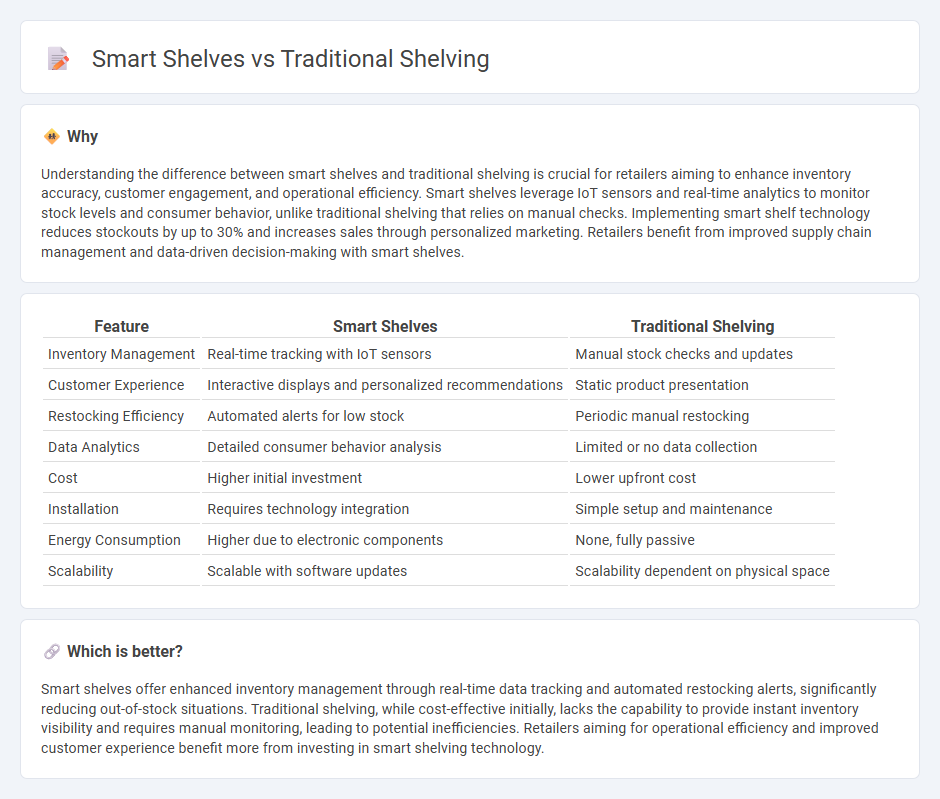
Smart shelves leverage IoT sensors and RFID technology to offer real-time inventory tracking and dynamic pricing, enhancing stock accuracy and customer engagement compared to traditional shelving. These advanced systems streamline restocking processes and reduce shrinkage, significantly improving operational efficiency. Explore how smart shelf technology is transforming retail environments and boosting profitability.
Why it is important
Understanding the difference between smart shelves and traditional shelving is crucial for retailers aiming to enhance inventory accuracy, customer engagement, and operational efficiency. Smart shelves leverage IoT sensors and real-time analytics to monitor stock levels and consumer behavior, unlike traditional shelving that relies on manual checks. Implementing smart shelf technology reduces stockouts by up to 30% and increases sales through personalized marketing. Retailers benefit from improved supply chain management and data-driven decision-making with smart shelves.
Comparison Table
| Feature | Smart Shelves | Traditional Shelving |
|---|---|---|
| Inventory Management | Real-time tracking with IoT sensors | Manual stock checks and updates |
| Customer Experience | Interactive displays and personalized recommendations | Static product presentation |
| Restocking Efficiency | Automated alerts for low stock | Periodic manual restocking |
| Data Analytics | Detailed consumer behavior analysis | Limited or no data collection |
| Cost | Higher initial investment | Lower upfront cost |
| Installation | Requires technology integration | Simple setup and maintenance |
| Energy Consumption | Higher due to electronic components | None, fully passive |
| Scalability | Scalable with software updates | Scalability dependent on physical space |
Which is better?
Smart shelves offer enhanced inventory management through real-time data tracking and automated restocking alerts, significantly reducing out-of-stock situations. Traditional shelving, while cost-effective initially, lacks the capability to provide instant inventory visibility and requires manual monitoring, leading to potential inefficiencies. Retailers aiming for operational efficiency and improved customer experience benefit more from investing in smart shelving technology.
Connection
Smart shelves and traditional shelving are connected through the shared goal of optimizing product display and inventory management in retail environments. Smart shelves enhance traditional shelving by integrating sensors and RFID technology to provide real-time stock monitoring, reducing out-of-stock situations and improving sales accuracy. Combining these technologies increases operational efficiency, enhances customer experience, and supports data-driven decision-making in retail stores.
Key Terms
Inventory Management
Traditional shelving relies on manual inventory checks and physical stock counts, which often lead to inaccuracies and stockouts. Smart shelves utilize embedded sensors and RFID technology to provide real-time inventory tracking, automate restocking alerts, and optimize stock levels. Explore how integrating smart shelves can revolutionize your inventory management system for increased efficiency and accuracy.
Real-time Data
Traditional shelving relies on manual inventory checks, often resulting in delays and inaccuracies. Smart shelves utilize sensors and RFID technology to provide real-time data on stock levels, improving inventory management and reducing out-of-stock issues. Explore how integrating real-time data with smart shelving can transform operational efficiency in retail and warehousing.
Planogram Compliance
Traditional shelving often leads to inconsistent product placement, increasing the risk of planogram non-compliance, which can affect sales and customer experience. Smart shelves use sensors and real-time data analytics to ensure accurate product positioning and efficient inventory management, improving planogram adherence. Discover how smart shelves can revolutionize retail operations and maximize planogram compliance.
Source and External Links
Floating Shelves vs. Traditional Shelving Options - Traditional shelving offers sturdy construction and versatile design options but occupies floor space and can appear bulky compared to floating shelves, making it ideal for heavy or large quantities of items.
Traditional|Bookcases|Bookshelf|Wood Furniture Store - Traditional bookcases feature classic heirloom styles with adjustable shelves, available in various woods and finishes, including custom sizes and features like doors and lighting.
Traditional Bistro Shelf Kits - Brown Wood Inc. - Traditional bistro shelving kits use lacquered brass and ball joints for an industrial look, come in multiple sizes and finishes, and include installation hardware.
 dowidth.com
dowidth.com